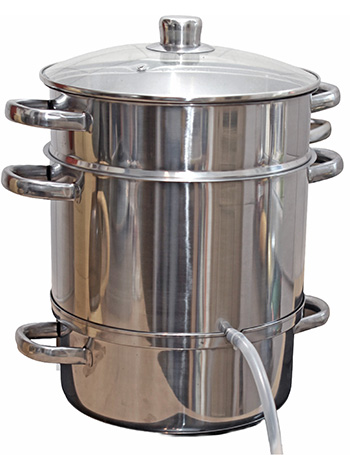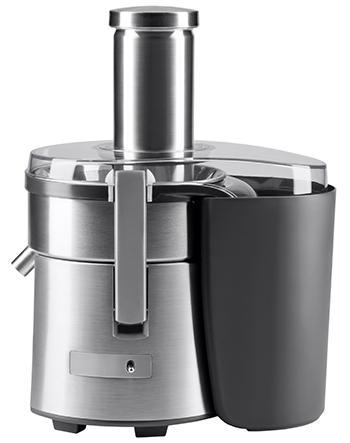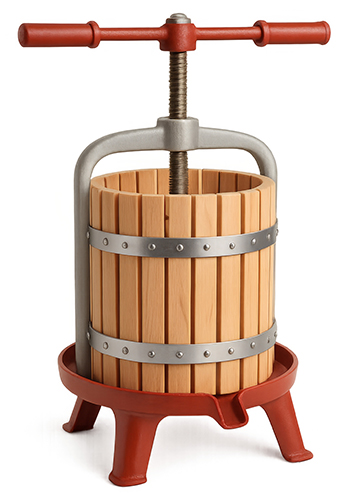Haskap juicing method comparison
A website summary of Haskap Juicing Method Effects on Haskap Juice Quality (doi.org/10.3390/app131910784).
by Zhuoyu Wang, Andrej Svyantek, Zachariah Miller*, Bridgid Jarrett, and Ashley Kapus
Western Agriculture Research Center, Montana State University, Corvallis, MT, 59828, USA; zachariah.miller@montana.edu
*Author to whom correspondence should be addressed.
Summary
This study compared three common juicing methods—centrifugal juicing (countertop fruit juicer), steam juicing, and wine pressing—to see how each affects the quality of juice made from ‘Aurora’ haskap berries. The results showed that the centrifugal juicer consistently produced the most nutrient-rich juice, with the highest levels of antioxidants, vitamin C, flavonoids, anthocyanins, and natural sugars. In contrast, steam juicing resulted in the lowest nutritional quality, likely due to the heat used during extraction and dilution of juice with water (steam). The wine press produced juice with moderate nutritional content, falling between the other two methods. Overall, centrifugal juicing proved to be the most effective method for preserving the health benefits and flavor of haskap juice.
Introduction
Although it is well known that haskap berries are high in anthocyanins and overall phenolic content compared to some other berries, such as blueberries, we don’t know much about how different juicing methods affect their nutritional value.
It's important to note that much of the nutritional value in haskap berries resides in the skins. To maximize health benefits, consuming whole berries—fresh or frozen—is the most effective approach. Still, developing value-added products like juice offers practical advantages, including extended shelf life and diversified income streams for fruit growers and processors.
Past studies on fruit juice processing have shown that the method used to extract juice can significantly affect its quality. Key findings include:
- Different techniques—like blending, pressing, or centrifugal juicing—produce juices with varying levels of nutrients, flavor, and clarity.
- Cold Pressing often preserves more antioxidants and nutrients compared to high-speed or heat-based methods.
- Heat-based methods (like steam juicing or pasteurization) can reduce vitamin C, anthocyanins, and other sensitive compounds.
- Blending retains fiber and pulp but may lead to faster oxidation.
- Advanced technologies like high-pressure processing, freeze crystallization, UV-C radiation, and cold plasma are being explored to improve shelf life and preserve nutrients without using heat.
This study compares three small-scale juicing techniques—steam juicing, centrifugal juicing, and pressing—to see which one retains the most nutrients and produces the best quality juice.
| Steam Juicer | Centrifugal juicer | Fruit press |
| Uses steam to heat fruit; juice drips into a collection container below. | High-speed spinning blade grinds fruit; centrifugal force separates juice from pulp. | Manually or hydraulically presses fruit to extract juice. |
 |
 |
 |
Extracting juice from haskap berries presents a unique challenge due to their high pectin content—a gel-like substance that makes pressing more difficult. When using a wine press (such as a bladder press), typical juice yields are around 50% by weight. For instance, pressing 10 pounds of berries will generally produce about 5 pounds of juice.
The goal of this study is to help growers and processors choose the best method for making high-quality haskap juice, whether for home use, farmgate sales, or commercial production.
Study Design
This study used ‘Aurora’ haskap berries grown at Montana State University’s Western Agricultural Research Center in 2022. The berries were frozen after harvest and thawed overnight before juicing.
Three juicing methods were tested using 5 kg of berries for each:
- Steam Juicer: Mr. Rodolf Steam Juicer, 50-minute extraction.
- Centrifugal Juicer: Hamilton Beach Juicer at 13,000 rpm, speed setting 2.
- Wine Press: SQUEEZE master fruit press at 3 Pa pressure.
After juicing, the following qualities were measured:
- Sugar & acidity: Measured using a digital refractometer (°Brix) and pH meter.
- Juice clarity (cloudiness): Measured after spinning samples in a centrifuge and checking light absorbance.
- Sugars (glucose, fructose, sucrose): Measured using a commercial sugar test kit after removing color pigments.
- Acids (malic, citric, tartaric): Measured using standard acid test kits.
- Color compounds (anthocyanins): Measured using a color test that compares juice at different pH levels.
- Antioxidants & phenolics:
-
- Juice was mixed with methanol and stored cold to extract antioxidants.
-
- Total phenolics were measured using a color-change test.
-
- Antioxidant strength was tested using two methods: DPPH (a free radical test) and FRAP (a test for reducing power).
- Flavonoids: Measured using a test that reacts with aluminum chloride and changes color.
- Vitamin C (Ascorbic Acid): Measured using a color test kit after removing solids from the juice.
Each juicing method was tested three times. Each test was repeated three times for accuracy. Results were analyzed using standard statistical methods to determine if differences were significant.
Key Findings
- The centrifugal juicer produced the sweetest, cloudiest, and most nutrient-rich juice.
- The wine press gave moderate results—in between centrifugal and steam juicing.
- The steam juicer produced the clearest juice but had the lowest sugar, color, and nutrient levels.
- Sugars: Glucose and fructose were highest in centrifugal and press juices. Steam juice had significantly less.
- Acids: Citric acid was the most abundant, followed by malic and tartaric acids. Steam juice had lower malic acid.
- Anthocyanins (color compounds): Highest in centrifugal and press juices. Steam juice had 32.5% less.
- Phenolics & Antioxidants: Centrifugal juice had up to 2x more than steam juice. Press juice was in between.
- Vitamin C: Highest in centrifugal juice, lowest in steam juice.
- Flavonoids: Followed the same trend—centrifugal > press > steam.
- Centrifugal juicer: Uses a rapidly spinning blade to shred fruit, then flings the pulp against a fine mesh filter to separate the juice from the solids. This process extracts more pulp and nutrients.
- Steam juicer: Uses heat, which can destroy sensitive nutrients like vitamin C and anthocyanins.
- Wine press: Gently squeezes berries with a water-filled bladder, preserving more nutrients than steam but less than centrifugal.
- Advanced technologies like cold plasma, ohmic heating, and high-pressure CO₂ could improve juice quality and shelf life. Using commercial enzymes to break down pectin, i.e., pectinace, can make Haskap juice easier. Preliminary information suggests that these enzymes can increase juice yields to 70%.
- Membrane filtration may help clarify juice without losing nutrients.
- Mixed juices and fermented haskap products are promising new markets.
- Consumer taste testing and preservation studies are needed to guide product development.
Conclusions
This study demonstrates that the method used to juice haskap berries significantly affects the nutritional quality of the resulting juice. Among the techniques tested, centrifugal juicing consistently produced the most nutrient-rich juice, with the highest levels of sugars, antioxidants, vitamin C, flavonoids, and anthocyanins. This method retains more skins and pulp, which are key sources of health-promoting compounds.
Wine pressing yielded moderate results—better than steam juicing, but not as nutrient-dense as centrifugal. Steam juicing produced the lowest nutrient levels, likely due to the high heat and dilution from steam.
In terms of health benefits, centrifugal juicing stood out, delivering:
- 4× more antioxidant activity than steam juice
- 50% more antioxidants than press juice
- Higher levels of all key health-promoting compounds
While this study focused on lab-scale juicing methods, the findings offer practical guidance for growers and processors. If the aim is to produce juice with the highest nutritional value, centrifugal juicing is the preferred method. That said, further research is needed to explore flavor and aroma profiles, which will be critical for developing market-ready haskap juice products that appeal to consumers.
Apply it: Using centrifugal juicing for high-quality haskap juice
- Start with frozen, thawed berries: The study used ‘Aurora’ haskaps that were frozen post-harvest and thawed before juicing. Freezing can help break down cell walls, potentially improving juice yield and the release of anthocyanins and phenolics. However, some vitamin C loss may occur during freezing. Results may vary with fresh berries.
- Use a high-speed centrifugal juicer: Look for commercial models that operate around 13,000 rpm or higher. At the time of this writing, the cost of these machines ranged between $300 and $3,000.
- Chill immediately.
Funding acknowledgement
This research is funded by the Montana Department of Agriculture Specialty Crop Block Grant, grant number 23SC00309. Project title: From Traditional to Unique Wines-Strategies to improve Montana’s Fermentation of Novel, Local Fruits.

